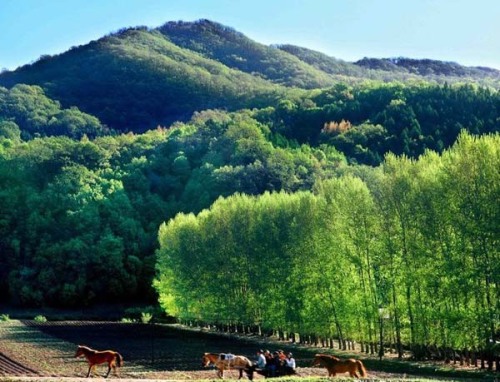Timber depleting China's forests
China's northeast is home to the largest and most important forested zone in the country. The forests of the Greater Hinggan, Lesser Hinggan, Zhangguangcai and Changbai mountain ranges have traditionally been the country's foremost sources of timber, making invaluable contributions to China's accelerated economic growth since 1949.
 |
|
Forests in the Greater Hinggan, northeast China |
This immense timber resource has always been the target of foreign marauders. In the years between 1929 and 1944, the Russians and Japanese destroyed 18 percent of the forest cover in the northeast, and 14.3 percent of the region's forest resources.
During this period, the Chinese Eastern Railway was used almost exclusively for the transport of timber from the northeast China to Russia, while the Ussuri (Musuli) River was full of floating logs destined for Japan.
An old photograph I saw many years ago showed a most painful sight: an entire forest reduced to waist-high stumps by the Japanese.
In the two years from 1948 to 1949, the northeast produced 6 million cubic meters of timber. In 1950, the planned quota was 4 million cubic meters, but the northeast alone yielded as much as 5.3 million cubic meters, of which 3.4 million cubic meters came from Heilongjiang Province.
In the five years from 1953 to 1957, the northeast produced almost 49 million cubic meters of timber - that's half of all timber produced by China in that period. Most of the timber came from the provinces of Heilongjiang and Jilin.
The timber from the northeast is very much a part of everyday life for people in China: as sleeper ties on railways; fuel in early locomotives; structural pillars in coal mines; carriages in automobiles; desks, blackboards and stationery in schools; and furniture and flooring in houses.
Most of the timber is obtained from the slow-growing Korean pine (Pinus koraiensis). Although a grown man could easily put his arms around the trunk of a mature tree, its slender stature belies the fact that most of these trees are really between 200 to 400 years old.
In the cold climate of the northeast, where temperatures rarely exceed 20 degrees Celsius in summer, these trees grow for only three to four months a year. In the days of indiscriminate logging, a worker could produce 500 cubic meters of timber a day - the equivalent of around 40-50 pines.
After almost 60 years of exploitation in the northeast, 60 percent of its primary pine forests are gone forever.
By 2004, there were hardly any mature trees left to be felled. In the Greater Hinggan Mountains, there were only around 7 million cubic meters of timber left. Assuming an annual production of 800,000 cubic meters, the forests would last only nine years.
That was the grim reality in 2004. Today's situation is far worse.
The depleted forests of the northeast are sending out warning signs in protest. One example was the 1998 flooding of the Songhua River. The lack of forest cover had led to accelerated erosion and widespread damage to the ecosystem.
Massive quantities of earth and mud were washed into the river, choking the channel flow and raising the riverbed by 30?50 centimeters. The once-clear Songhua River is now as turbid as the Yellow River.
In contrast, the forests in Russia possess some 90 billion cubic meters of timber, of which 60 percent are mature trees. With such a vast potential, it is no surprise that Russia is now China's top supplier of timber.
This could be welcome news for the forests in the northeast. Even now these forests are still being overexploited, and they continue to supply a quarter to a third of China's timber.
Perhaps it is time to take a step back. Pinewood from Russia is a perfectly acceptable substitute for Northeast timber - after all, the tree species are exactly the same.
So why not let the northeast forests have a break and give them a chance to regenerate?
 0
0 







Go to Forum >>0 Comments